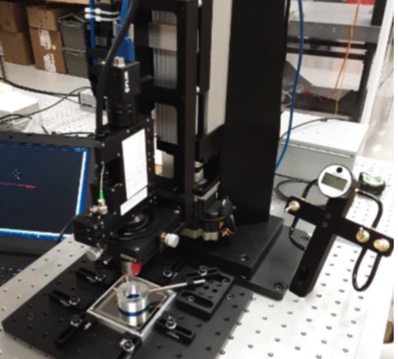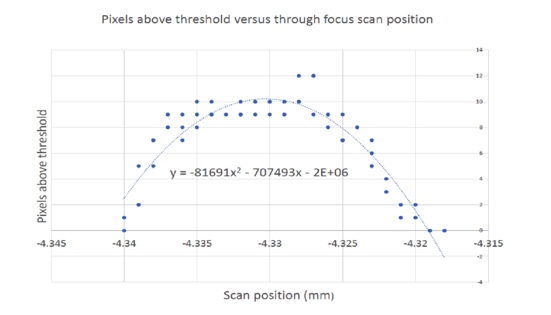How Repeatably Can the Point Source Microscope Find Best Focus at a Center of Curvature?
Recently, a client asked how well can you focus if you really had to do better? I did not know but it was easy to do an experiment with our centering station that has a motorized stage and the ability to log data as the stage moves.
It is easily demonstrated that the PSM lateral sensitivity to centroiding on a return reflection from a center of curvature is better than 1 μm with a 10x objective. In the usual case the sensitivity is better than 0.2 μm. However, the sensitivity axially, or in the direction of focus is less sensitive, typically ± 2-3 μm judging by the size and shape of the image on the video screen.

WAS I SURPRISED BY THE RESULTS!
Using our centering station I got repeatability of better than 0.1 μm using the center of a 1/8” steel ball as my mirror and a 10x objective with a NA of 0.25 on the PSM. Classically, the depth of focus is λ/2*NA or about 0.635/.5 = 1.27 μm in this case.
To do the experiment to find focus you have to adjust the shutter speed on the PSM so there are about 10-15 pixels above threshold at what appears from the video screen to be best focus. The area designation on the PSM control panel is a count of the number of pixels above threshold so the illumination is easy to set to get the right number of pixels. Then you scan through where you expect best focus while logging the number of pixels above threshold as you scan. These data are saved to a file that is then copied to Excel. When the data of number of pixels versus scan position are plotted as in the graph below you can fit a second order polynomial as shown in the equation on the chart.

Remembering that we can find the maximum of the curve by taking the derivative and setting it to zero, we get -2*81691*x -707493 = 0, or x = 4.3303 mm. When this scan was repeated another 4 times I got 4.3303, 4.3302, 4.3303 and 4.3301 mm as the scan position at maximum pixels above threshold. This represents repeatability of less than 0.1 μm even though the data are rather noisy due to the small number of pixels used in the data.
This experiment points out the advantage of using a digital camera on the PSM. Without the ability to digitize the intensity at each pixel it would be impossible for this process to work.
The exact set of parameters used in this experiment may not be optimized, but this data shows the remarkable sort of focus repeatability that can be achieved with the PSM. It may be possible to do even better.
USA

Innovations Foresight
4432 Mallard Point,
Columbus, IN 47201 USA
Telephone:
1-215-884-1101
Contact:
Customerservice@
All Asian Countries Except China

清 原 耕 輔 Kosuke Kiyohara
清原光学 営業部 Kiyohara Optics / Sales
+81-3-5918-8501
opg-sales@koptic.co.jp
Kiyohara Optics Inc.
3-28-10 Funado Itabashi-Ku Tokyo, Japan 174-0041
China

Langxin (Suzhou) Precision Optics Co., Ltd
1st floor, Building 10, Yisu Science and Technology Innovation Park, 100 meters west of the intersection of Xinhua Road and Weimeng Road, Kunshan City, Suzhou City, Jiangsu Province, 215345
Telephone: +860512-57284008
Contact: Wang Zengkun
+8617090133615
wangzengkun@langxinoptics.com
Copyright ©
Website by CS Design Studios
Headquarters: 7011 E Calle Tolosa, Tucson, AZ 85750
Laboratory: 1661 S Research Loop, Tucson, AZ 85710
